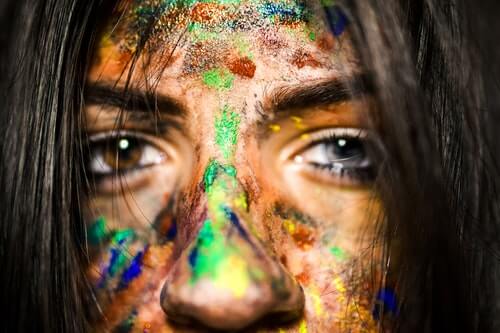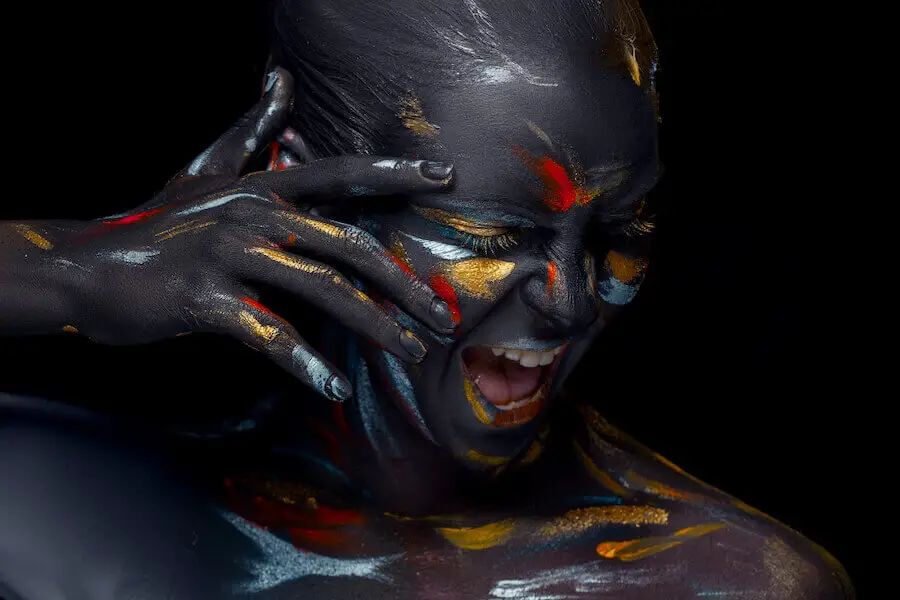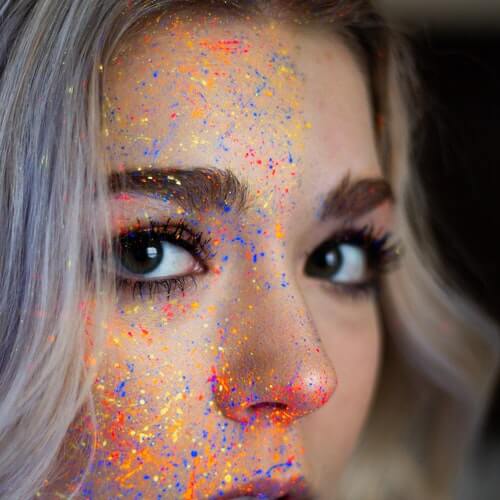If you’re curious about whether or not you can use acrylic paint on your face, you’re in the right place.
Acrylic paint is a versatile medium that can be used for a variety of projects, from painting to crafting. Many people often wonder if it’s safe to use acrylic paint on their skin, specifically their face.
Here we’ll explore the pros and cons of using acrylic paint on the face and give you some tips on how to do it safely.
Keep reading to learn more!
Can You Use Acrylic Paint As Face Paint?
Acrylic paints are water-based and made with pigment that is suspended in an emulsion of water and acrylic polymer. This “suspension” allows the colorant (pigment) to remain wet and open to chemical reactions for longer periods of time than traditional oil paints. Because they are water-based, acrylics don’t dry to a hard finish as oil-based paints do.
When used in small quantities, it is considered very safe to use acrylic paint on skin. Many people use it as face paint or tattoos with no issues at all! Acrylic paint is non-toxic when used in small quantities.
If you were using large quantities it might be wise to avoid inhaling the pigment, same as you would with any art media, but the chances of this happening are slim.

With that said, children should not wear acrylic paint as face paint because there are other products available that are made specifically for kids without harsh chemicals that can be easily washed off with soap and water.
It is important to remember that, face paint is meant to be used for short periods of time.
If you wanted to wear it for a long period of time without any discomfort, we recommend using non-toxic and water-resistant gel-based paints like Mehron Paradise or Snazaroo.
Typically kids under three should not use face paint because they might end up consuming some while trying to lick or eat it.
Is Acrylic Paint Safe On Skin?
Acrylic paint is a popular medium for artists because it is versatile and can be used to create a wide range of textures. However, due to worries over the years, people often have concerns that acrylic paint might not be safe to use on the skin.
Acrylic paint is not designed to be applied to the face or skin but it can be used in small quantities. Despite the fact that it isn’t particularly harmful, it includes acrylic paint pigments that may cause serious skin irritation and damage.

With that said, acrylic paint is popular among artists because it is cheap and easy to use. It’s also water-resistant, which means you may easily wash any spills or mishaps away with water.
Acrylic paints are often used by artists because they are safe to use in small amounts on the skin. While it is generally regarded as harmless, some individuals may be sensitive to it.
If you are concerned about using acrylic paint on your skin, do a test patch first to determine if you will have negative reactions or not.
What Kind Of Paint Is Safe For Face?
There are many different kinds of paints that can be used on the face. Acrylic paint is just one type of paint that can be used on body painting projects in small doses.
When considering what kind of paint is safe for the face, it becomes important to understand what kind of project you are undertaking.

For example, some people may prefer to use non-toxic water-based paints while others may only want to use paints specifically labeled “facepaint.”
It’s important to know exactly what kind of project you’re doing before purchasing your supplies so that you can properly choose the right paints for your skin.
Is Paint Dangerous On Skin?
Acrylic paint is not typically dangerous for your skin, but there are some cases where it could be harmful. Most of the time acrylic paint is non-toxic and won’t cause negative reactions in most people
In some rare cases though, an individual may have a severe reaction to pigments in certain brands or colors of acrylic paint. Even then, it’s important to remember that face painting is meant to be used for short periods of time only and the paint should always be washed off when finished.
Always do a patch test first if you’re concerned about how your skin will react before starting any type of face painting project.
What Paint Is Best For Body Painting?
When it comes to choosing the best paints for body painting, you’ll want to consider several factors. The type of paint you decide on will depend on what kind of project you are undertaking

For example, with certain projects like face painting or tattooing, you may prefer non-toxic water-based paints. But when using water-based paints be careful because they might smudge if applied over moisturized areas. If this is a concern then it’s wise to use a makeup sealer with your water-based face paint before applying it to your skin.
If the thought of dealing with liquid products doesn’t thrill you, then perhaps using water-resistant paints like Ben Nye face paint might be the best fit for your project.
Whatever kind of body painting you are using, it’s important to test out your body paints on a small patch of skin before applying them all over your body or face.
You can do this by painting a small area of skin and leaving it there for several hours. If you don’t experience any negative reactions after doing this initial patch test, then your skin should be safe from harm.
If you still have concerns about how the paint will react to your skin, then do a second patch test. This time leave the paint on longer and check on it every few hours over the course of a few days.
If no negative reactions occur after the second patch test, then you should be good to paint on your face or body.
Painting your Body with Acrylic Paint
If you tried using water-based acrylic paint and had no negative reactions, then it’s safe to paint your body with it.

You can find both water-based and non water-based paints that will work well on the skin.
Step 1 – Equipment Needed
Make sure you have all of your tools ready before you begin. The following are some of the equipment you’ll need:
- Face and body paint
- Sponge or a brush
- Towel or wet wipes
- Stencils
- Spray bottle
Step 2 – Get Your Skin Ready
Before applying any paint to your skin, it’s important that you prep the surface first. This includes moisturizing the skin as well as using a primer to help your makeup stick properly. In most situations, water will work well for this but if you have dry skin then use a moisturizer instead.
Using an oil-based product can cause pilling to occur on top of your skin so be sure to choose the best primer for the job.
Step 3 – Add Some Color
The next step is to add paint colors of your choice into a bowl then mix them together until you get the desired look. You can opt for one color, multiple colors, dark colors, bright colors, or a combination of them all.
The main thing to consider is whether you want a bold or subtle look before choosing a color palette for your body paint design.
Step 4 – Apply Paint with Tools
Once the paint has been prepared, it will be time to apply it to your skin. Doing this requires using certain tools like brushes, sponges, or stencils.

You can also use spray bottles if you want to make the process easier on yourself.
Just remember that your first layer of paint should be light as possible so that any mistakes made with the design can be covered up later on without taking too much of the paint away.
Once your first layer is applied, you should wait for about an hour or two before adding any more paint to make sure that it’s completely dry and won’t smudge. The drying time will depend on the weather conditions and the type of paint used.
Step 5 – Seal Your Paint Job
After you’re satisfied with your body painting job, use a fine brush to finish off the design. The last step is to seal it using a makeup sealer spray.
This will help your body paint stay on for longer and prevent it from smudging or flaking off in the days following your event.
Some of the benefits of sealing your body paint include:
- Helps achieve vibrant colors that don’t fade easily.
- Makes clean up easier.
- Helps paint stay on for longer.
Step 6 – Taking Care of Your Skin
Once you are done, it’s important to cleanse the skin thoroughly with a bar of mild soap and warm water. This will help prevent any negative reactions from occurring due to leftover paint or makeup that’s been absorbed into the pores of your skin.
If you experience a negative reaction to the paint or if it gets into your eyes then rinse with a lot of clean water and consult a doctor for proper treatment.
Final Thoughts
Acrylic paint is generally regarded as harmless when used on the skin so long as it isn’t ingested and not left on for excessively long periods of time.
Once applied to your skin acrylic paint will stay put until thoroughly washed off with water.
Paint will remain safely on most types of skin but in some cases, it may cause irritation or allergic reactions in rare cases. When using paints that might irritate your skin, always do an initial patch test first before applying it all over. You can do this by painting a small area of skin and leaving it there for several hours to see if any negative reactions occur
In many cases, water-based paint works best when used on skin since it’s easy to remove simply with soap and water. But in some cases you might want to use latex or oil-based paints instead, so always read the instructions properly and test out your paints before using them.

